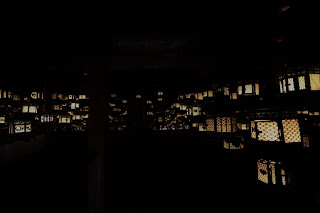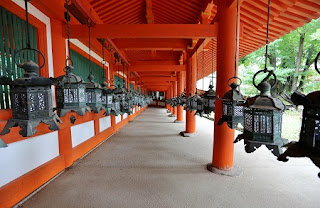World Heritage watching ; Kasuga Taisha Shrine
Nara is a city with a population of 1.4 million, attracting many tourists. In Nara, a lot of tourist assets that came from Japan's history and culture are scattered all around. Nara is within easy access of the other big cities such as Tokyo, Osaka, and Kyoto, so you can arrange your journey in various ways. (Source)
春日大社は、今からおよそ1300年前、奈良に都ができた頃,平城京鎮護のため、遠く鹿島神宮から最強の武神である武甕槌命(タケミカヅチノミコト)様を神山御蓋山(ミカサヤマ)山頂浮雲峰(ウキグモノミネ)にお迎えしたのがはじまりです。
Kasuga Taisha Shrine
春日大社
Ancient myths tell us that about 1300 years ago when the national capital was built in Nara, Takemikazuchi-no-mikoto came all the way from Kashima Shrine (Ibaraki Prefecture) to Mt. Mikasa, which is considered a holy mountain, to dwell on its summit “Ukigumo-no-mine” for the prosperity of the nation and happiness of the people. Later on, when Tempyo Culture flourished, the political leader Fujiwara-no-Nagate built magnificent buildings on the present site of the shrine as ordained by Empress Shotoku. On November 9, 768, he enshrined several gods here, namely Futsunushi-no-mikoto from Katori Shrine (Chiba Prefecture), and Amenokoyane-no-mikoto and Himegami from Hiraoka Shrine (Osaka Prefecture). This is how Kasuga Taisha began.
Kasuga Taisha Shrine
About Kasuga Taisha Shrine
Google map
Both path to this shrine are lined with approx. 2000 stone lanterns, and the eaves of the shrine itself are decorated with around a thousand hanging bronze lanterns. It is also impressive to see the vermillion colored shrine buildings with the natural environment.
The Shrine lies in a primeval forest of cedars and a kind of Chinese black pines. The brilliant vermilion edifices are beautifully contrasted with their surrounding greenery. Going through the first and second Torii gates, you can see a lot of stone lanterns standing on both sides of the approach to the shrine. Going on further, you will find the south gate on the left. The main hall is located among trees behind the gate. From the gate a corridor extends to the left and to the right.
A great number of lanterns hung from the eaves of the corridor are producing an elegant atmosphere.
In the 3rd year of the Wado era (710), when the capital was transferred to Nara, Fujiwara-no-Fuhito celebrated a mass for tutelary deities of the Fujiwara family, which is considered to be the origin of this shrine. In the 2nd year of the Jingo-Keiun era (768), shrine buildings started to be constructed here. Just like the Kofuku-ji Temple,shrine buildings were added, along with the prosperity of the Fujiwara family. In the first half of the Heian period (794-1192), shrine buildings were completed on the same scale as they are today. After the Middle Ages, the belief was prevalent among commoners, which is shown by the fact that various-shaped hanging lanterns and stone lanterns known as "Mantoro" were mostly the donations from common people.
The tutelary deities enshrined here are Takemikazuchi-no-Mikoto from Kashima of Ibaraki Prefecture, Futsunushi-no-Mikoto from Katori of Chiba Prefecture, Amenokoyane-no-Mikoto and Himegami from Hiraoka of Osaka Prefecture.
"Why are there so many deer here ?"
"Why are there so many deer here ?"
According to legend, when Kasuga Taisha Shrine was founded as a family shrine for the Fujiwaras, a dominant aristocrat clan in the 8th century, they invite a mighty god from Kashima Shrine (in present day Ibaraki prefecture). The god is said to have come to Nara riding on a white deer. Since then, deer have been respected and protected as divine messengers by local people.
Shinkansen
新幹線
新幹線
Japanese foods are good and safe.
Because of stricter food safety law by Japanese government, we have no worry about foods.
Matcha
抹茶
Ice & Fruits
Ekiben ; A box lunch sold at a railroad station
駅弁
Salada
サラダ
4 years have passed since Fukushima Daiichi nuclear power plant accident. I have visited various places of Japan to see the health consequence of the accident.
Fortunately I have never found any impacts by the accident among Japanese creatures. As far as I know, nobody has health problem which is caused by the accident in Japan.
Our Prime Minister Abe assures that "The situation is under control. The influence of the contaminated water is completely blocked within Fukushima. There are no health-related problems until now and there will never be health problems." He also said that "Tokyo is 250 kilometers away from Fukushima, and the kind of danger that you imagine does not exist in Tokyo. Tokyo is a very safe city."
As PM Abe said, Nara Prefecture is very far away from Fukushima, people in there have no concern about the nuclear power plant accident. People in there have already forgotten the accident, because they think radioactive materials cannot reach there.
We know there is no problem for childbirth and child rearing in Nara Prefecture. So people in there have no concern about the accident.
I continue to visit various places in Japan to see the effects of the accident, because I can meet various creatures which are more sensitive to radioactive materials from the environment. It is important to see their health for our safety.
公衆衛生ネットワーク
Public Health Network in Japan













0 件のコメント:
コメントを投稿